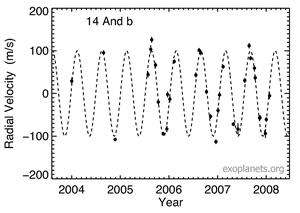14 Andromedae b
| Exoplanet | List of exoplanets | |
|---|---|---|
 | ||
| Parent star | ||
| Star | 14 Andromedae | |
| Constellation | Andromeda | |
| Right ascension | (α) | 23h 31m 17.41s[1] |
| Declination | (δ) | +39° 14′ 10.3″[1] |
| Apparent magnitude | (mV) | 5.22 |
| Distance | 258 ± 6[1] ly (79 ± 2[1] pc) | |
| Spectral type | K0III | |
| Orbital elements | ||
| Semi-major axis | (a) | 0.83[2] AU |
| Eccentricity | (e) | 0[3] |
| Orbital period | (P) | 185.84±0.23[3] d |
| Time of periastron | (T0) | 2861.4 ± 1.5[2] JD |
| Semi-amplitude | (K) | 100.0 ± 1.3[3] m/s |
| Physical characteristics | ||
| Minimum mass | (m sin i) | 5.33 ± 0.57[3] MJ |
| Discovery information | ||
| Discovery date | July 2, 2008 | |
| Discoverer(s) | Sato et al.[2] | |
| Discovery method | Doppler Spectroscopy[2] | |
| Discovery status | Published[2] | |
| Other designations | ||
Spe, HD 221345 b | ||
| Database references | ||
| Extrasolar Planets Encyclopaedia | data | |
| SIMBAD | data | |
| Exoplanet Archive | data | |
| Open Exoplanet Catalogue | data | |
14 Andromedae b (abbreviated 14 And b), also named Spe, is an extrasolar planet approximately 249 light years away in the constellation of Andromeda.
The 186-day period planet orbits about 83% the Earth-Sun distance from the giant star 14 Andromedae. It has a minimum mass 4.8 times the mass of Jupiter. The planet orbits with an eccentricity of 0.0094, which means the orbital distance over the course of its revolution varies by only 0.02 AU.[2]
Nomenclature
In July 2014 the International Astronomical Union launched a process for giving proper names to certain exoplanets and their host stars.[4] The process involved public nomination and voting for the new names.[5] In December 2015, the IAU announced the name Spe for this planet.[6] The winning name was based on that submitted by the Thunder Bay Centre of the Royal Astronomical Society of Canada[7]); namely 'Spes', Latin for 'hope'. (Spes was also the Roman goddess of hope.) The IAU substituted the ablative form 'Spe', which means 'where there is hope', to match that given to the host star at the same time.[8]
Discovery
The preprint announcing 14 Andromedae b was submitted to the arXiv electronic repository on July 2, 2008 by Bun'ei Sato and collaborators, who discovered it using the Doppler Spectroscopy method, during the Okayama Planet Search radial velocity survey of G and K giants at Okayama Astrophysical Observatory.[2]
See also
References
- 1 2 3 4 van Leeuwen, F. (2007). "Validation of the new Hipparcos reduction". Astronomy and Astrophysics. 474 (2): 653–664. arXiv:0708.1752. Bibcode:2007A&A...474..653V. doi:10.1051/0004-6361:20078357. Vizier catalog entry
- 1 2 3 4 5 6 7 Sato, Bun'ei; et al. (2008). "Planetary Companions to Evolved Intermediate-Mass Stars: 14 Andromedae, 81 Ceti, 6 Lyncis, and HD167042". Publications of the Astronomical Society of Japan. 60 (6): 1317–1326. arXiv:0807.0268. Bibcode:2008PASJ...60.1317S. doi:10.1093/pasj/60.6.1317.
- 1 2 3 4 Ligi, R.; et al. (2012). "A new interferometric study of four exoplanet host stars : θ Cygni, 14 Andromedae, υ Andromedae and 42 Draconis". Astronomy and Astrophysics. 545. A5. arXiv:1208.3895. Bibcode:2012A&A...545A...5L. doi:10.1051/0004-6361/201219467.
- ↑ NameExoWorlds: An IAU Worldwide Contest to Name Exoplanets and their Host Stars. IAU.org. 9 July 2014
- ↑ NameExoWorlds The Process
- ↑ Final Results of NameExoWorlds Public Vote Released, International Astronomical Union, 15 December 2015.
- ↑ Thunder Bay Amateur Astronomers Name a Planet
- ↑ NameExoWorlds The Approved Names
External links
- "14 Andromedae". Exoplanets. Retrieved 2008-08-06.
- Jean Schneider (2011). "Notes for Planet 14 And b". Extrasolar Planets Encyclopaedia. Retrieved 30 September 2011.